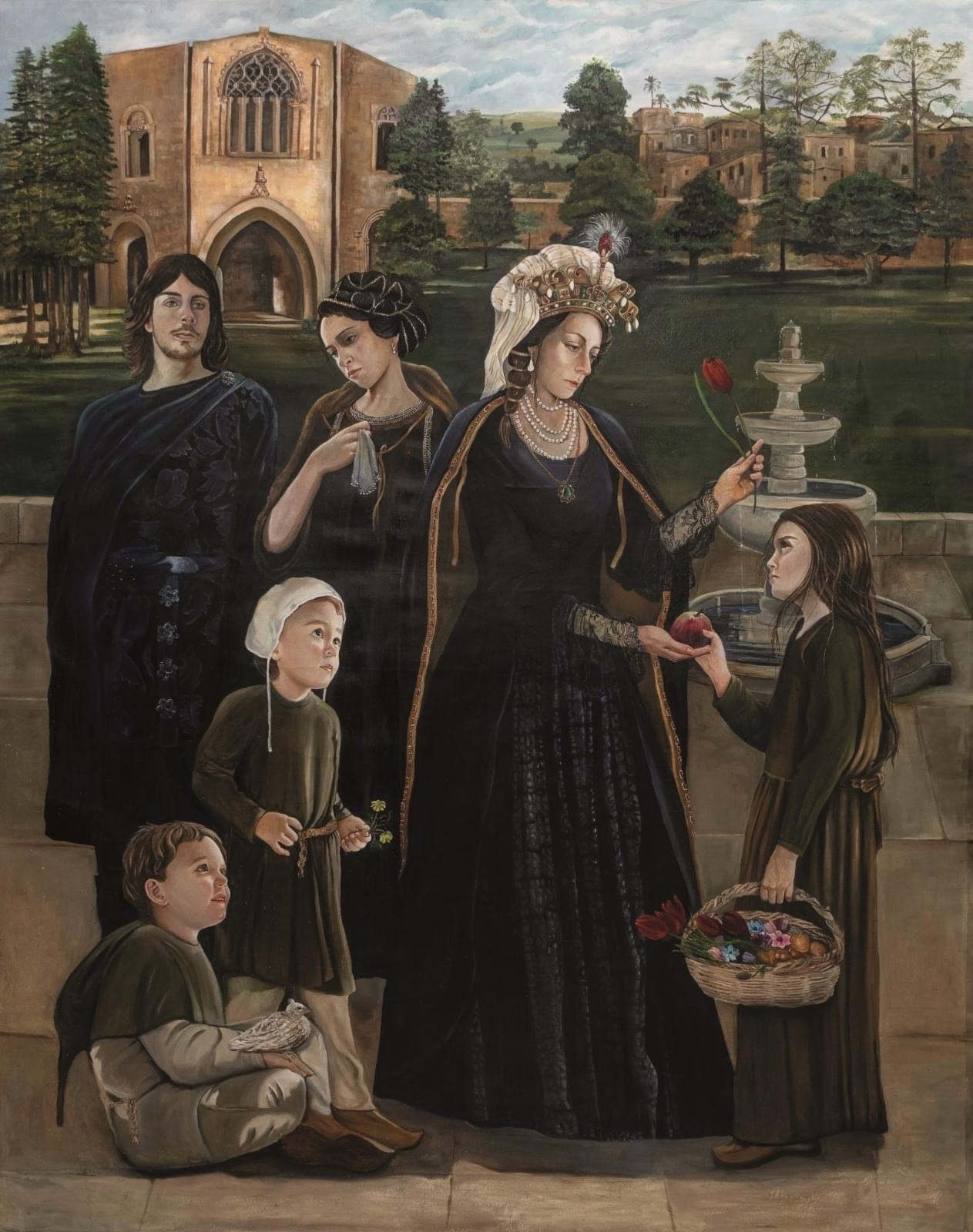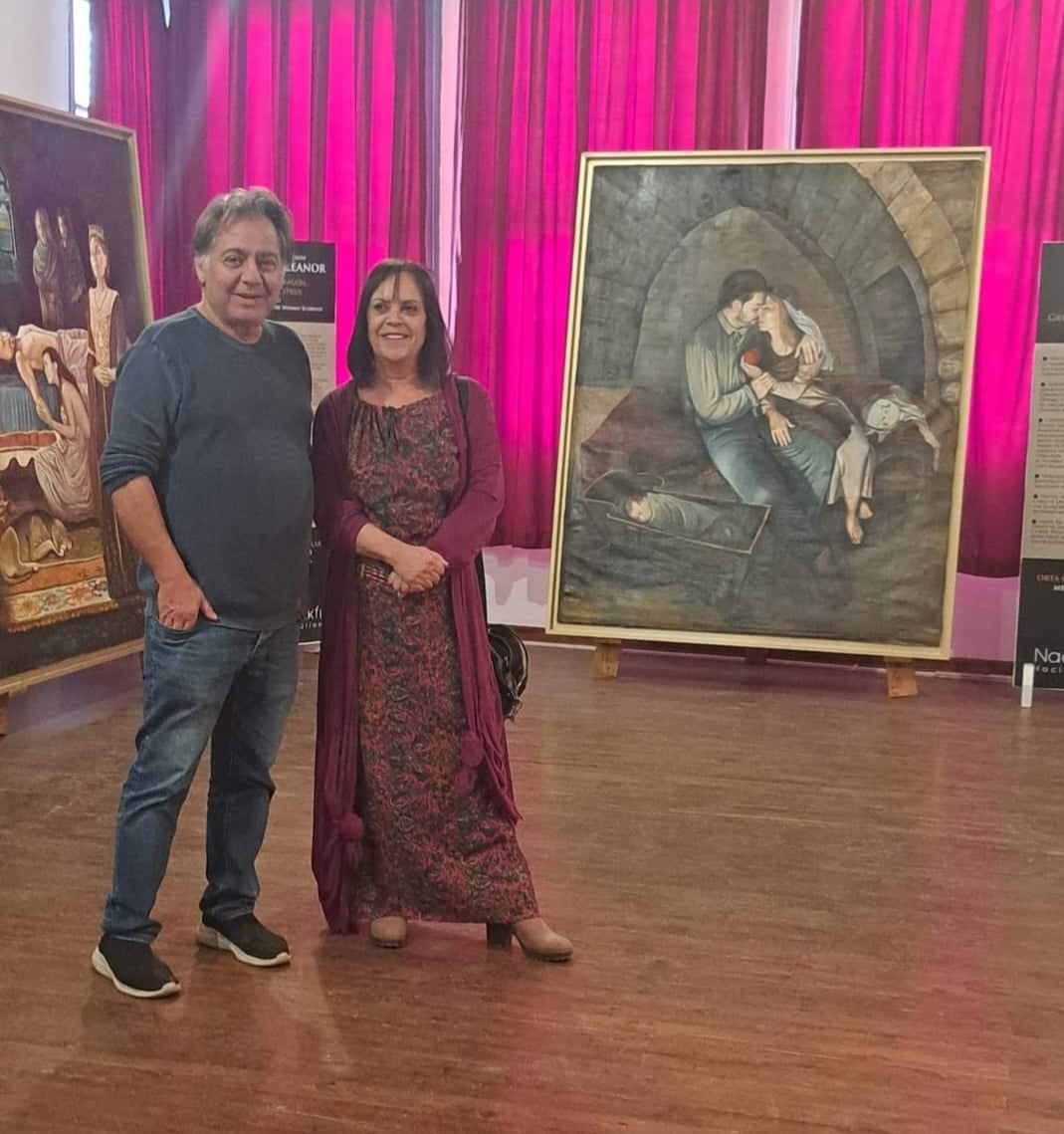A sympathetic reappraisal of Cyprus’ ‘horrible women’
The exhibition “Mediaeval Women of Cyprus”, just opened in old Famagusta, is a joint project of two Turkish Cypriots, the mediaevalist Ahmet Hilmi and artist Semra Bayhanli
The show, that was first on display in March in the old town of north Nicosia, consists of seven large canvasses portraying some of the most significant women in the island’s mediaeval history.
The paintings are the result of a collaboration between UK-based Hilmi, whose expertise with its focus on mediaeval society and gender studies contributed to the narrative along with the visionary skills of Bayhanli, one of the north’s leading artists.
Each of the portraits, executed in a classic style, aims at telling its subject’s story, starting with that of Alice of Champagne, daughter of the legendary crusader Count Henry of Champagne and Queen Isabel of Jerusalem. Alice, who was to marry King Hugh I of Cyprus, one of the island’s first Lusignan kings, is credited in local lore with sending a supposedly vintage-shaking Cypriot vine sampling to Champagne.

Among other notables featured in the exhibition are Eleonor of Aragon, wife of the legendary Peter I. Her cruelty towards the king’s mistress is immortalised in the Cypriot folk song “Arodafnousa”. Then there is Anna of Lusignan, the daughter of King Janus of Cyprus, who was to bear Louis, the Count of Savoy, 19 children, and a line of descendants that may have included Princess Diana and Winston Churchill. Yet another portrait is that of the beautiful Arnalda de Rochas, who, when captured by the Ottoman army in the 1570 siege of Nicosia, was despatched by ship, destined to join the Sultan’s harem, only to commit suicide by blowing up the galleon’s arsenal.
“The mediaeval times in Cyprus are extremely interesting but very often ignored because on both sides our educators are more interested in focusing on the nationalist versions of our history,” says Hilmi who was born in the Paphos village of Faleia (Falya), not far from where the original Arodafnousa, Joanna D’Aleman, had lived.
“During Lusignan times, Cyprus was part of something much bigger – it was a fascinating cosmopolitan society. People often spoke many languages and Famagusta harbour was full of vessels from all over the Mediterranean. But when one reads about this period, very little is said about women. Nobody mentions them because they had a very specific role defined by the church – to stay at home, take care of children, and make sure to give birth to a son because daughters were not really important.”
Ahmet Hilmi notes that it was only when a woman had a son, that she acquired a degree of influence. “When she divorced or became a widow, she could become really powerful, because then she could get her dowry back and start making decisions. Even then, if her family wanted to control her, they could force her to remarry or send her to a nunnery.”
And yet, he continues, he came across many women in the course of his studies who had resisted and struggled against this distribution of power and authority.

“They were women in the upper echelon of the system, educated, knowledgeable, determined. They were able to challenge men and often they did.”
According to Hilmi, many of these women had horrible reputations. Certainly “very few” were liked because, as he puts it, women were known to be “responsible for original sin”. Anna who married the count of Savoy, for example, was a case in point.
“Anna’s husband was very much in love with her and not really interested in running the country. He liked poetry and hunting and gradually left her to manage state affairs. And she did a very good job of it. She was a patron of art and culture. She also had a brilliant adviser in her aunt Agnes, the princess of Cyprus and abbess of Wunstorf, who accompanied her to Savoy. Anna’s daughter Charlotte married Louis XI and became queen of France. When Anna died she left behind a collection of some hundred manuscripts, which contributed to the establishment of the Bibliothèque Nationale de France. And yet, local people hated Anna because she was a foreigner. They even called her a ‘scorpion’.”
Another Cypriot mediaeval aristocrat, Queen Eleonor, who was often looked upon as the local “Cruella”, was similarly disliked.
“Eleonor has a very bad reputation but when you look at her story it is easy to see she didn’t have too many choices. Her problem was two-fold: to start with she was a Catalan, so she was alone in Cyprus where most of the aristocracy was French or Italian; secondly, her husband was a womaniser. Eleonor had a son but Peter’s mistress was also going to have a baby. That meant that anything could happen. She had to think of the future – hers and her son’s. The tragedy is that while she wins her battle with Peter and the aristocracy to retain power, once her son marries, he gets rid of his mother, sending her back to Barcelona…”
Bayhanli who was born in Nicosia’s Kucuk Kaymakli confesses that as a child she didn’t like history much because, just as Hilmi says, most of the time it was too one-sided and women were ignored.
She first met Hilmi during an exhibition of hers in north Nicosia and soon discovered they had common interests.
“Ahmet kept on telling me about these incredibly interesting women and I started imagining how I would paint them. So finally I said ‘OK, let’s do this project together’ and so we started to work on it.”
Since their collaboration began around the time of the pandemic, they were forced to spend much of their time exchanging ideas online.
“Ahmet kept on sending me stories and I kept on sending back my ideas and sketches. A lot of what I was painting and drawing came from my imagination but I also did a lot of research on women’s fashion from this period. And I kept on looking for right faces. I wanted to use Cypriots as my models and had it not been for the corona period I would have loved to have both Greek and Turkish Cypriots. However, in the circumstances, I focused on Turkish Cypriots.”
Rich in detail and symbolism, the masterfully executed paintings, each 160x200cm in dimensions, include the original coats of arms of the aristocratic families of mediaeval Cyprus and are vibrantly alive with action and emotions.
“I always listen to classical music when I paint. This was especially true during the painting of Caterina Coronaro, the last queen of Cyprus, I chose very sad pieces. I cried a lot when I was painting her,” Bayhanli confides.
The first exibition in north Nicosia was visited by about 5,000 people. Now Hilmi and Bayhanli are hoping to repeat the success in Famagusta and plan to travel the show not just to other places in Cyprus, including south Nicosia, but also to the UK, France, Spain, and Italy. Ultimately they would love to find a permanent space for their heroines to settle in.
“We want to bring to life this forgotten part of history and these women who struggled for power and authority. They are Cypriot characters but they could be from anywhere in Europe. These women represent both Cypriot and European history. They remind us that Cyprus is also part of Europe – much more than we realise,” Hilmi says.
The project, that also includes portraits of two other queens of Cyprus, Plaisance of Antioch and Helvis of Brunswick-Grubenhagen, was self-funded, with some assistance from the Naci Talat Foundation, and includes an accompanying guide book.
Medieval Women of Cyprus
Famagusta, Old Town, Martinengo Bastion, May 24-31, Open every day, including weekends: 8am-5pm







Click here to change your cookie preferences